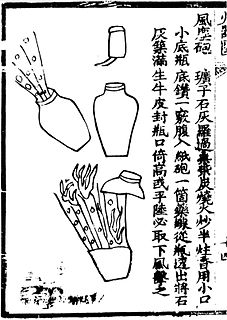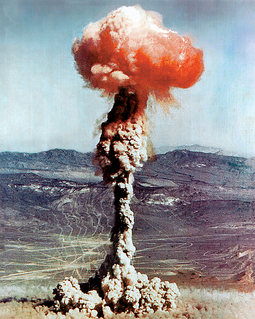External links
- RAND Corporation's list of unclassified (non-secret) reports by Harold Brode
- Some online links to Brode's blast and cratering analysis
| This article about an American physicist is a stub. You can help Wikipedia by expanding it. |
Harold L. Brode is a nuclear weapons effects physicist who pioneered computer simulations of nuclear explosions at the RAND Corporation in the 1950s. In 1951 he received his PhD from Cornell University where his supervisor was Hans A. Bethe. He is co-founder of R&D Associates, Vice-President of Strategic Systems at Pacific-Sierra Research Corporation and Chairman of the U.S. Defense Nuclear Agency's Scientific Advisory Group for Effects (SAGE) [ permanent dead link ].
One of his critics commented in Physics Today, vol. 58: "Harold Brode probably knows more about nuclear weapons effects than any other person alive."
| This article about an American physicist is a stub. You can help Wikipedia by expanding it. |

"Little Boy" was the codename for the type of atomic bomb dropped on the Japanese city of Hiroshima on 6 August 1945 during World War II. It was the first nuclear weapon used in warfare. The bomb was dropped by the Boeing B-29 Superfortress Enola Gay piloted by Colonel Paul W. Tibbets, Jr., commander of the 509th Composite Group of the United States Army Air Forces and Captain Robert A. Lewis. It exploded with an energy of approximately 15 kilotons of TNT (63 TJ) and caused widespread death and destruction throughout the city. The Hiroshima bombing was the second man-made nuclear explosion in history, after the Trinity test.

The Tunguska event was a massive explosion that occurred near the Podkamennaya Tunguska River in Yeniseysk Governorate, Russia, on the morning of 30 June 1908 (NS). The explosion over the sparsely populated Eastern Siberian Taiga flattened an estimated 80 million trees over an area of 2,150 km2 (830 sq mi) of forest, and eyewitness reports suggest that at least three people may have died in the event. The explosion is generally attributed to the air burst of a stony meteoroid about 100 metres in size. It is classified as an impact event, even though no impact crater has been found; the object is thought to have disintegrated at an altitude of 5 to 10 kilometres rather than to have hit the surface of the Earth.

A bomb is an explosive weapon that uses the exothermic reaction of an explosive material to provide an extremely sudden and violent release of energy. Detonations inflict damage principally through ground- and atmosphere-transmitted mechanical stress, the impact and penetration of pressure-driven projectiles, pressure damage, and explosion-generated effects. Bombs have been utilized since the 11th century starting in East Asia.

The effects of a nuclear explosion on its immediate vicinity are typically much more destructive and multifaceted than those caused by conventional explosives. In most cases, the energy released from a nuclear weapon detonated within the lower atmosphere can be approximately divided into four basic categories:

Project Plowshare was the overall United States program for the development of techniques to use nuclear explosives for peaceful construction purposes. As part of the program, 31 nuclear warheads were detonated in 27 separate tests. Plowshare was the US portion of what are called Peaceful Nuclear Explosions (PNE); a similar Soviet program was carried out under the name Nuclear Explosions for the National Economy.

A mushroom cloud is a distinctive pyrocumulus mushroom-shaped cloud of debris, smoke and usually condensed water vapor resulting from a large explosion. The effect is most commonly associated with a nuclear explosion, but any sufficiently energetic detonation or deflagration will produce the same effect. They can be caused by powerful conventional weapons, like thermobaric weapons, including the ATBIP and GBU-43/B Massive Ordnance Air Blast. Some volcanic eruptions and impact events can produce natural mushroom clouds.

Detonation is a type of combustion involving a supersonic exothermic front accelerating through a medium that eventually drives a shock front propagating directly in front of it. Detonations occur in both conventional solid and liquid explosives, as well as in reactive gases. The velocity of detonation in solid and liquid explosives is much higher than that in gaseous ones, which allows the wave system to be observed with greater detail.

"Duck and cover" is a method of personal protection against the effects of a nuclear explosion. Ducking and covering is useful at conferring a degree of protection to personnel situated outside the radius of the nuclear fireball but still within sufficient range of the nuclear explosion that standing upright and uncovered is likely to cause serious injury or death. In the most literal interpretation, the focus of the maneuver is primarily on protective actions one can take during the first few crucial seconds-to-minutes after the event, while the film by the same name and a full encompassing of the advice, also caters to providing protection up to weeks after the event.

Elugelab, or Elugelap, was an island, part of the Enewetak Atoll in the Marshall Islands. It was destroyed by the world's first true hydrogen bomb test on 1 November 1952, a test which was codenamed shot "Mike" of Operation Ivy. Prior to being destroyed, the island was described as "just another small naked island of the atoll".

Storax Sedan was a shallow underground nuclear test conducted in Area 10 of Yucca Flat at the Nevada National Security Site on July 6, 1962, as part of Operation Plowshare, a program to investigate the use of nuclear weapons for mining, cratering, and other civilian purposes. The radioactive fallout from the test contaminated more US residents than any other nuclear test. The Sedan Crater is the largest human-made crater in the United States and is listed on the National Register of Historic Places.
Peaceful nuclear explosions (PNEs) are nuclear explosions conducted for non-military purposes. Proposed uses include excavation for the building of canals and harbours, electrical generation, the use of nuclear explosions to drive spacecraft, and as a form of wide-area fracking. PNEs were an area of some research from the late 1950s into the 1980s, primarily in the United States and Soviet Union.

The explosive yield of a nuclear weapon is the amount of energy released when that particular nuclear weapon is detonated, usually expressed as a TNT equivalent (the standardized equivalent mass of trinitrotoluene which, if detonated, would produce the same energy discharge), either in kilotons (kt—thousands of tons of TNT), in megatons (Mt—millions of tons of TNT), or sometimes in terajoules (TJ). An explosive yield of one terajoule is equal to 0.239 kilotonnes of TNT. Because the accuracy of any measurement of the energy released by TNT has always been problematic, the conventional definition is that one kiloton of TNT is held simply to be equivalent to 1012 calories.
In fluid dynamics, a blast wave is the increased pressure and flow resulting from the deposition of a large amount of energy in a small, very localised volume. The flow field can be approximated as a lead shock wave, followed by a self-similar subsonic flow field. In simpler terms, a blast wave is an area of pressure expanding supersonically outward from an explosive core. It has a leading shock front of compressed gases. The blast wave is followed by a blast wind of negative pressure, which sucks items back in towards the center. The blast wave is harmful especially when one is very close to the center or at a location of constructive interference. High explosives that detonate generate blast waves.
An underwater explosion is a chemical or nuclear explosion that occurs under the surface of a body of water.

Underground nuclear testing is the test detonation of nuclear weapons that is performed underground. When the device being tested is buried at sufficient depth, the nuclear explosion may be contained, with no release of radioactive materials to the atmosphere.

Operation Sailor Hat was a series of explosives effects tests, conducted by the United States Navy Bureau of Ships under the sponsorship of the Defense Atomic Support Agency. The tests consisted of two underwater explosions at San Clemente Island, California in 1964 and three surface explosions at Kahoʻolawe, Hawaii in 1965. They were non-nuclear tests employing large quantities of conventional explosives to determine the effects of a nuclear weapon blast on naval vessels, and the first major test of this kind since Operation Crossroads in July 1946.
Radioflash is a term used in early literature on the phenomena now known more widely as nuclear electromagnetic pulse, or EMP. The term originated in the early 1950s, primarily associated with the "click" typically heard on radio receivers when a nuclear bomb was detonated. It was later discovered that the phenomena was one part of the more wide-ranging set of effects resulting from EMPs after the detonation of nuclear and certain chemical weapons.
Richard Latter was a theoretical physicist, who was famous for his political involvement in the United States during the Cold War, where he warned against MIRVs developed in Soviet Russia, by which arms-reduction treaties could be evaded.
Nuclear shaped charges refers to nuclear weapons that focus the energy of their explosion into certain directions, as opposed to a spherical explosion. Edward Teller referred to such concepts as third-generation weapons, the first generation being the atom bomb and the second the H-bomb.